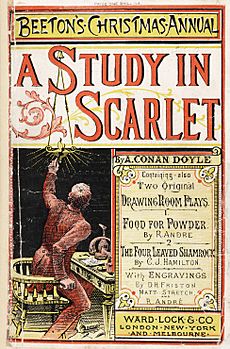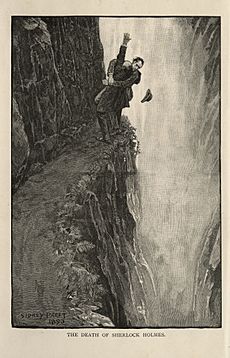Sherlock Holmes facts for kids
Quick facts for kids Sherlock Holmes |
|
|---|---|
| Sherlock Holmes character | |
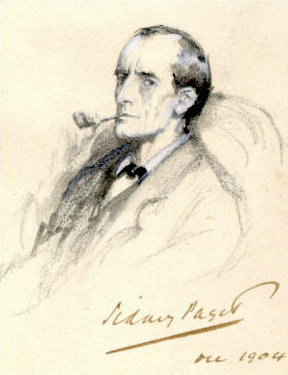
Sherlock Holmes in a 1904 illustration by Sidney Paget
|
|
| First appearance | A Study in Scarlet (1887) |
| Last appearance | "The Adventure of Shoscombe Old Place" (1927, canon) |
| Created by | Sir Arthur Conan Doyle |
| Information | |
| Occupation | Consulting private detective |
| Family | Mycroft Holmes (brother) |
| Nationality | British |
Sherlock Holmes is a famous fictional detective. He was created by the British writer Sir Arthur Conan Doyle. Holmes calls himself a "consulting detective." This means he helps people solve mysteries. He is known for being super good at observing things, using logic, and understanding forensic science. He uses these skills to solve many different cases. Sometimes, even the police like Scotland Yard ask for his help.
Sherlock Holmes first appeared in a book called A Study in Scarlet in 1887. He became very popular when his short stories started appearing in The Strand Magazine in 1891. The first story in the magazine was "A Scandal in Bohemia." More stories were published until 1927. In total, there are four novels and 56 short stories. Most of these stories take place between 1880 and 1914. This was during the Victorian and Edwardian times in England.
Most of the stories are told by Holmes's good friend, Dr. John H. Watson. Dr. Watson is also Holmes's biographer. He often goes with Holmes on his cases. They also live together at 221B Baker Street in London. Many of the stories begin right there.
Sherlock Holmes was not the very first fictional detective. But he is probably the most famous one. By the 1990s, there were over 25,000 plays, movies, TV shows, and books about him. Guinness World Records even lists him as the most played human character in movies and TV. Many people have believed that Holmes was a real person because he is so popular. Fans have even created clubs based on this idea. The stories have greatly influenced mystery writing and popular culture. The original tales and thousands of new stories by other authors have been made into plays, movies, and video games for over 100 years.
Who Inspired Sherlock Holmes?
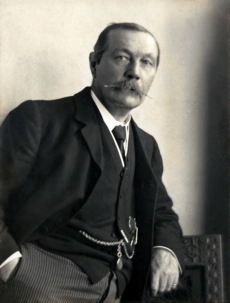
Many people believe that Edgar Allan Poe's character, C. Auguste Dupin, was the first detective in fiction. Dupin helped inspire many later detective characters, including Holmes. Conan Doyle once said that Poe's detective stories were like the "root" for all detective literature.
Another inspiration was Joseph Bell. He was a surgeon whom Conan Doyle met in 1877. Conan Doyle even worked for him. Like Holmes, Bell was known for making big conclusions from small details. However, Bell later told Conan Doyle that Conan Doyle himself was "Sherlock Holmes." Sir Henry Littlejohn, a medical expert, also inspired Holmes. He helped Conan Doyle see the link between medical science and solving crimes.
Some other ideas for Holmes's inspiration have been suggested. One is a French detective named Maximilien Heller from an 1871 novel. Another is a German "consulting detective" named Walter Scherer. But Conan Doyle never confirmed these.
Sherlock Holmes's Story
His Family and Early Life
The stories don't give many details about Sherlock Holmes's early life. But we can piece together some information. Holmes was born in 1854. His parents are not mentioned. However, he says his "ancestors" were "country squires." This means they were landowners.
Holmes also mentions that his grandmother was related to the famous French artist Vernet. His older brother, Mycroft, is seven years older than him. Mycroft works for the government. He is like a human database, knowing everything about government policy. Sherlock says Mycroft is even smarter than him. But Mycroft doesn't like to do physical investigations. He prefers to spend his time at the Diogenes Club.
Holmes says he first started using his detective skills in college. His first cases were for other students. A meeting with a classmate's father made him decide to become a professional detective.
Life with Dr. Watson
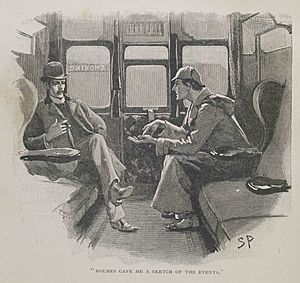
Holmes and Dr. Watson decided to share rooms at 221B Baker Street in London because of money problems. Their landlady, Mrs. Hudson, takes care of their home. Holmes works as a detective for 23 years. Watson helps him for 17 of those years.
Most of the stories are told from Watson's point of view. He writes down the detective's most interesting cases. Holmes often says that Watson's stories are too dramatic. He thinks they don't show the true "science" of his work.
Holmes's friendship with Watson is very important to him. When Watson gets shot, Holmes shows how much he cares. Watson says it was "worth a wound" to see the "depth of loyalty and love" behind Holmes's calm face. Holmes even tells their opponent that he would not have left the room alive if he had truly killed Watson.
How Holmes Works
Holmes helps all kinds of clients. He works for powerful leaders and governments. He also helps wealthy people and even ordinary people like pawnbrokers. At first, only a few people know about him. But as Watson publishes his stories, Holmes becomes very famous. By 1887, "Europe was ringing with his name." By 1895, he had "an immense practice."
Police outside London often ask Holmes for help. Even a Prime Minister and the King of Bohemia visit him for help. The President of France gives him an award for catching a criminal. He also helps the Vatican more than once. Holmes helps the British government with national security. He even turns down a knighthood for his secret work. But he doesn't really seek fame. He is usually happy to let the police get the public credit.
The Great Hiatus
The first Sherlock Holmes stories were published between 1887 and 1893. Conan Doyle decided to kill off Holmes in a fight with the criminal genius Professor James Moriarty. This happened in the story "The Final Problem," published in 1893. Conan Doyle felt he needed to focus on other writing.
But the public's reaction was huge! Readers sent angry letters to The Strand Magazine. The magazine lost 20,000 subscribers. Conan Doyle himself got many protest letters. One lady even started her letter with "You brute." People say Londoners were so sad that they wore black armbands. This shows how much people loved Holmes.
After eight years, Conan Doyle wrote The Hound of the Baskervilles (1901–02). Then, in 1903, he wrote "The Adventure of the Empty House." In this story, Holmes reappears! He explains to a shocked Watson that he faked his death to trick his enemies. Conan Doyle continued to write Holmes stories until 1927.
Fans call the time from 1891 to 1894 the "Great Hiatus." This is the period when Holmes was thought to be dead.
Retirement Life
In the story His Last Bow, Holmes has retired. He lives on a small farm in the Sussex Downs. His main hobby is beekeeping. This move probably happened by 1904. In His Last Bow, Holmes and Watson come out of retirement. They help Britain during World War I. Only one other adventure, "The Adventure of the Lion's Mane," happens during his retirement.
Holmes's Personality and Habits
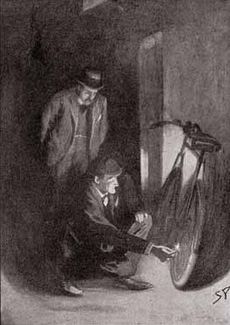
Watson describes Holmes as having a "bohemian" lifestyle. This means he doesn't always follow normal rules. He loves to be clean, but his home is often messy. Watson says he is "one of the most untidy men." Holmes keeps his cigars in the coal-scuttle. He puts his tobacco in a slipper. He even sticks unanswered letters to his mantelpiece with a knife! He also hates throwing away papers. So, his room is full of bundles of documents.
While Holmes can seem cold, he gets very excited during an investigation. He likes to surprise people. He often keeps his methods secret until the very end. Watson agrees that Holmes sometimes bends the rules. He might keep secrets from the police or enter houses without permission. But he does this only when he thinks it's the right thing to solve a case.
Holmes doesn't like casual company, except for Watson. He once told Watson that he only made one friend in college. He says he was "never a very sociable fellow." Sometimes, Holmes doesn't eat when he's thinking hard. He believes that "the faculties become refined when you starve them." Holmes also enjoys music. He plays the violin and listens to composers like Wagner.
His Money Matters
Holmes charges his clients for his work. He also takes any rewards offered for solving a problem. For example, in "The Adventure of the Speckled Band," he earns a good fee. He says his "professional charges are upon a fixed scale." But he sometimes helps people for free. Wealthy clients often pay him more than his usual rate. In "The Adventure of the Priory School," Holmes earns £6,000. This was a lot of money back then. However, Watson notes that Holmes would refuse to help even rich people if their cases didn't interest him.
How He Sees Women
Holmes once said he was "not a whole-souled admirer of womankind." He found "the motives of women... inscrutable." He also said, "Women are never to be entirely trusted." Watson called this an "atrocious sentiment." Holmes believed that emotions could cloud his judgment. He said, "I should never marry myself, lest I bias my judgement." He even claimed, "I have never loved."
But Watson also noted that Holmes had a "peculiarly ingratiating way with [women]." Their housekeeper, Mrs. Hudson, liked Holmes. This was because he was "remarkably gentle and courteous" to women.
Irene Adler
Irene Adler is a retired American opera singer. She appears in "A Scandal in Bohemia." She only appears once. But she is one of the few people who ever outsmarted Holmes. She is also the only woman to do so. Holmes thinks very highly of her. He always calls her the woman. Watson says, "In his eyes she eclipses and predominates the whole of her sex."
Five years before the story, Adler had a brief relationship with Prince Wilhelm of Bohemia. The Prince was about to get married. He hired Holmes to get back a photograph of Adler and himself. He feared it would ruin his marriage. But Adler managed to escape before Holmes could get the photo. Holmes keeps a photo of Adler as a reminder of her cleverness.
What Holmes Knows and Can Do
When Watson first met Holmes, he wrote down what Holmes knew:
- Literature: Not much.
- Philosophy: Not much.
- Astronomy: Not much.
- Politics: Weak.
- Botany (plants): Varies. Knows a lot about belladonna and poisons. Doesn't know about gardening.
- Geology (rocks and soil): Practical, but limited. Can tell different soils apart. Can tell where someone has been by the mud on their clothes.
- Chemistry: Very deep knowledge.
- Anatomy (body parts): Accurate, but not organized.
- Sensational Literature (crime stories): Huge knowledge. Knows every detail of every horror story.
- Plays the violin well.
- Is an expert at singlestick (a type of sword fighting), boxing, and swordsmanship.
- Has good practical knowledge of British law.
In A Study in Scarlet, Holmes says he doesn't know the Earth goes around the sun. He thinks such facts are useless for his work. He believes the mind has limited space for information. Learning useless things takes up space for useful things. However, in later stories, he changes his mind. In The Valley of Fear, he says, "All knowledge comes useful to the detective."
Holmes is also good at solving secret codes. He says he wrote a book about 160 different codes. He also understands psychology. In "A Scandal in Bohemia," he tricks Irene Adler into revealing where she hid a photo. He knew a woman would try to save her most important possession from a fire.
Holmes's Deduction Skills
Holmes is famous for his "deduction" skills. He looks at small details about people. These include marks on their skin, dirt on their clothes, their feelings, and their physical state. From these, he figures out where they came from and what they've done recently. He also looks at clothes and personal items. For example, in "A Scandal in Bohemia," Holmes figures out that Watson got wet. He also knows Watson has a clumsy servant.
Holmes explains: "On the inside of your left shoe... the leather is scored by six almost parallel cuts. Obviously they have been caused by someone who has very carelessly scraped round the edges of the sole in order to remove crusted mud from it." From this, he knew Watson had been out in bad weather. He also knew Watson had a careless servant.
Holmes's main rule is: "When you have eliminated the impossible, whatever remains, however improbable, must be the truth." This means if you rule out everything that can't be true, what's left must be the answer, even if it seems unlikely.
Forensic Science in Holmes's Work
Holmes is known for his reasoning. But he also uses a lot of physical evidence. Many of the techniques he used were new at the time.
He is very good at analyzing small clues. These include footprints, hoof prints, and tire marks. He uses tobacco ashes and cigarette butts to identify criminals. He also analyzes handwriting and typewritten letters. He can even use gunpowder residue to find murderers.
Holmes often uses a magnifying glass at crime scenes. He uses a microscope at his home. He also uses analytical chemistry to find blood and poisons. His home chemistry lab is mentioned in "The Naval Treaty." In "The Adventure of the Empty House," he matches bullets to a suspected murder weapon. This became a regular police method years later.
Holmes's methods were often ahead of official police work. But they were based on real techniques of his time. He inspired many future forensic scientists to think scientifically.
Master of Disguise
Holmes is also very good at acting and using disguises. In several stories, he uses disguises to gather information secretly. These disguises are so good that Watson doesn't even recognize him! In other stories, Holmes pretends to be hurt or sick to trick criminals. Watson once said that the "stage lost a fine actor" when Holmes became a detective.
Holmes's ability to change his appearance helped him blend into any situation. He could become like a "chameleon."
Holmes's Helpers
Before Watson arrived, Holmes mostly worked alone. He sometimes used agents from the poorer parts of London. These agents included people who gave him information. For example, Langdale Pike knew all about social scandals. Shinwell Johnson was his agent in London's criminal world. The most famous of Holmes's helpers were a group of street children. He called them "the Baker Street Irregulars."
Sherlock Holmes's Impact
How He Changed Detective Stories
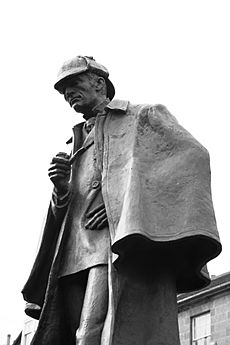
Holmes is not the first detective in stories. But his name is now linked with the idea of a detective. Conan Doyle's stories introduced many new ideas to detective fiction. For example, the detective has a companion who isn't as smart. The detective explains things to this companion, which also helps the reader understand. Dr. Watson is this companion for Holmes.
Other new ideas include the "arch-criminal." This is a super-smart villain who is too clever for the police. Holmes's enemy, Professor Moriarty, is an example. The use of forensic science to solve cases also became popular because of Holmes.
The Sherlock Holmes stories made crime fiction a respected and popular type of story. Conan Doyle's success inspired many other detective stories. Holmes influenced other "eccentric gentleman detective" characters. One example is Agatha Christie's Hercule Poirot. Holmes also inspired "anti-hero" characters. These are like opposites of the masterful detective. Examples include the "gentleman thief" characters A. J. Raffles and Arsène Lupin.
"Elementary, My Dear Watson"
The phrase "Elementary, my dear Watson" is very famous. It's one of the most quoted things about Sherlock Holmes. However, Holmes never actually says this exact phrase in any of Conan Doyle's stories! He often says his conclusions are "elementary." And he sometimes calls Watson "my dear Watson." But never together.
One of the closest lines is in "The Adventure of the Crooked Man" (1893). Holmes explains something, and Watson says, "'Excellent!' I cried. 'Elementary,' said he."
The actor William Gillette is thought to have started the phrase. He might have said something like, "Oh, this is elementary, my dear fellow," in his 1899 play Sherlock Holmes. The phrase became very well known in America. This was partly because it was used in the Rathbone-Bruce series of films from 1939 to 1946.
Museums and Collections
For the 1951 Festival of Britain, Holmes's living room was rebuilt. It was part of a Sherlock Holmes exhibition. After the festival, some items went to The Sherlock Holmes pub in London. Others went to a collection in Lucens, Switzerland. Both places have a Baker Street sitting-room display that people can visit.
In 1969, the Toronto Reference Library started a collection about Conan Doyle. It is in Room 221B and is open to the public. In 1974, the University of Minnesota started a collection. It is now the "world’s largest gathering of material related to Sherlock Holmes." It is sometimes open for tours.
In 1990, the Sherlock Holmes Museum opened on Baker Street in London. The next year, a museum opened in Meiringen (near the Reichenbach Falls). This museum is also about the detective. A private Conan Doyle collection is on display at the Portsmouth City Museum. This is where the author lived and worked.
Sherlock Holmes Stories
Novels
- A Study in Scarlet (published November 1887)
- The Sign of the Four (published February 1890)
- The Hound of the Baskervilles (published in parts 1901–1902)
- The Valley of Fear (published in parts 1914–1915)
Short Story Collections
The short stories were first published in magazines. Later, they were gathered into five books:
- The Adventures of Sherlock Holmes (stories from 1891–1892)
- The Memoirs of Sherlock Holmes (stories from 1892–1893)
- The Return of Sherlock Holmes (stories from 1903–1904)
- His Last Bow: Some Later Reminiscences of Sherlock Holmes (stories from 1908–1917)
- The Case-Book of Sherlock Holmes (stories from 1921–1927)
See also
 In Spanish: Sherlock Holmes para niños
In Spanish: Sherlock Holmes para niños
- List of Holmesian studies
- Popular culture references to Sherlock Holmes
- Sherlock Holmes fandom
Images for kids
-
Waxwork of Robert Downey Jr. as Holmes on display at Madame Tussauds London


